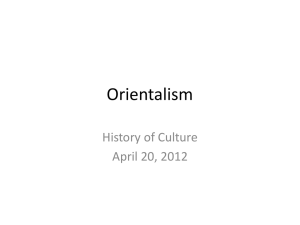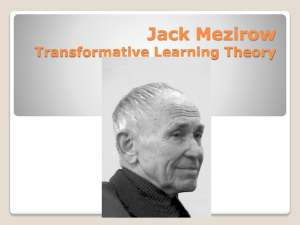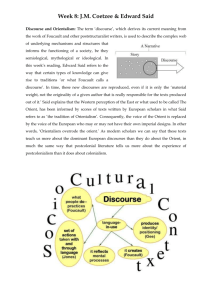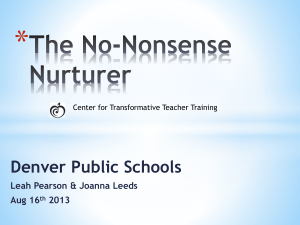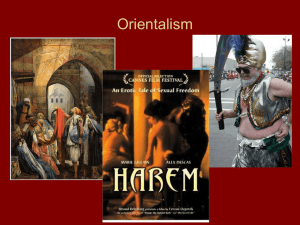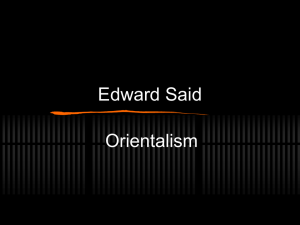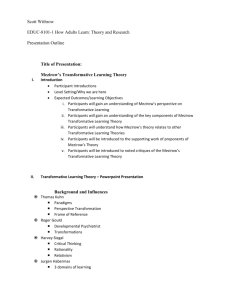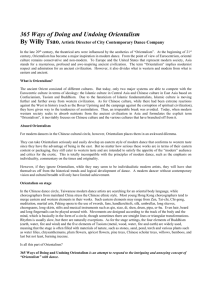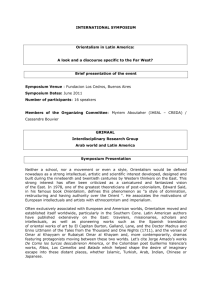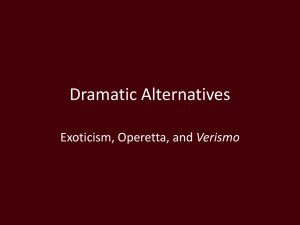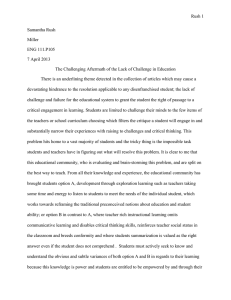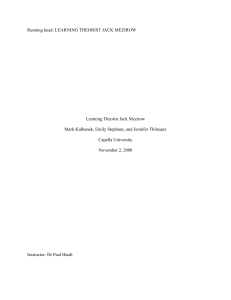slide
advertisement
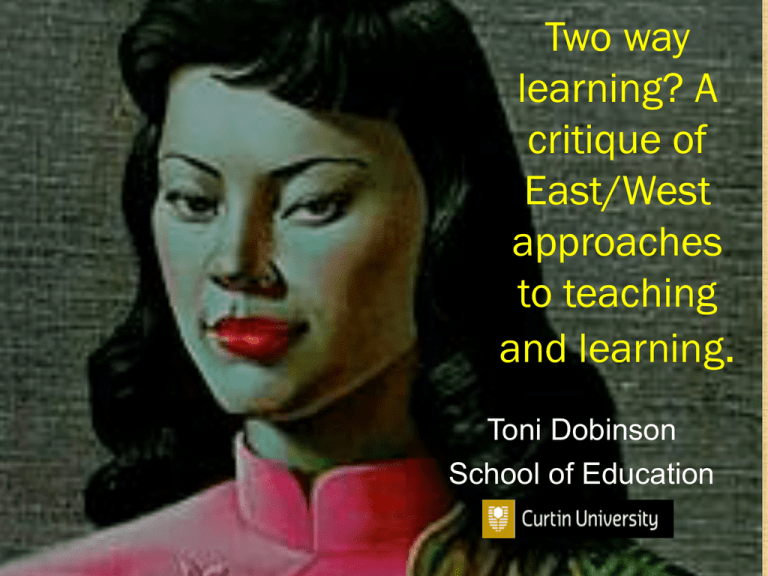
Two way learning? A critique of East/West approaches to teaching and learning. Toni Dobinson School of Education Internationalisation International education has made a significant contribution to Australia. It has grown to now be our third largest source of overseas earnings ... The Hon Julia Gillard MP ( May 2009) Statistics • In Australia -Annual export figure for educational activity of $18.3 billion in 2010 (AEI, 2011) • $10.4 billion (59%) in Higher Education • Top 10 contributors were: China (24.3%) India (14.6%) Republic of Korea (5.7%) Malaysia (4.6%) Vietnam (4.5%) Thailand (3.8%) Indonesia (3.3%) Nepal (3.0%) Hong Kong (2.8%) Brazil (2.0%) Other (including Saudi Arabia – 28.2%) Transnational Educational Programmes • In 2009, 320,970 international students studying with an Australian institution of higher education • 100,492 (31.3%) of these studying offshore (AEI, 2011) • MA (Applied Linguistics) course taught transnationally in Ho Chi Min City. • Exchange of ideas about teaching and learning between Vietnamese lecturers and Australian lecturers on same course. • Literature describing approaches to teaching and learning in terms of an ‘Orientalist Binary Paradigm’ (Takayama, 2008). • Discourses on Orientalism and ‘othering’ Organisation of the presentation • Approaches to teaching and learning • Social and theoretical discourses on Asia and ‘othering’ • ‘Spilling over’ of these discourses into research on ‘Asian’ approaches to teaching and learning • Ways forward for teaching and learning in the Asia Pacific region. • Mechanistic out – organismic, Humanistic in (Rogers, Maslow, Tennant, Bloom, Freire • The learning society (Schon, Hutchins, ) • Transformative learning –– instrumental learning out – communicative learning in (Mezirow) • Learning =action collectively or individually, emotional , spiritual (Mezirow, Daloz, Cunningham, Boyd) • Experiential and informal (workplace) in – classroom out (Boud, Eraut) • ‘Orientalism as a Western style for dominating, restructuring, and having authority over the Orient’. ( Said, 1978, p.3) Orientalism-almost a European invention…one of its deepest and most recurring images of the ‘other’ (Saud, 1978, p.1) The European is a close reasoner; his statements of fact are devoid of any ambiguity; The mind of the Oriental , on the other hand , like his picturesque streets, is eminently wanting in symmetry The Oriental generally acts, thinks and speaks in a manner exactly opposite to the European (Cromer, 1908) ‘selective amnesia’ ‘denying of creativity and originality’ ‘continued essentially the same’ (Tavakoli-Targhi, Malcolm) Women – demure, sensual, subservient Men- cold, inscrutable, cruel Spilling over into reports of Asian approaches to learning? EARLY : • reproductive (rote) • dependent on teacher • pragmatic/surface • passive – listen and obey (Noesjirwan, 1970; Chan, 1999; Ballard, 1989) Confucius versus Socrates • Passivity, obedience, lack of creativity or critique, pragmatic (surface) learning, instrumental learning attributed to Confucian East. • Questioning, evaluating, doubting, critiquing (deep) and communicative learning attributed to Socratic West (also deriving from Dewy (1899, 1916) Setting the record straight- Confucian influence • Confucius urged his students to sift his teachings and criticise his statements: 11:4 → Hui is no help to me at all. He is pleased with everything I say. • He didn’t necessarily endorse teacher/student dependence: The teacher does not have to be more knowledgeable than the pupil; and the pupil is not necessarily always less learned than the teacher (cited in Cheng, 2000, p. 4) • Dialectic→Ways of thinking and socio-political structures - Confucian attitudes a product of time of stability – Taoism, Buddhism approaches different – less stable (Geyer, 2003). Setting the record straight- Socratic influence • Learning (surface/deep) in Western universities dependent upon nature and year of course (Kirkpatrick & Mulligan, 2002) ‘Deep’ approach takes years to develop – even for academics (Haggis, 2003) • Memorisation does not preclude deep understanding (Kember, 2000). • Critical’ thinking often just means mirroring lecturer’s ideas (Webb, 1997; Sandeman-Gay, 1999) • Asking Asian students to critically think in university settings - are we really just asking them to imitate our preferred learning style? This is Behavourist not organismic (Kegan, 1994).See Mahbubani quote • Not always safe for students to articulate critical thought e.g. Indonesian student Continued • Can have a teacher centred approach which produces independent learners (Brookefield, 1985a) • Western learning theory and teaching practices = ‘grand narrative’ , ‘hegemonies’ that don’t fit reality of most learners in mass educational systems (Haggis, 2003) • Mental colonisation – power and privileged versus feelings of worthlessness, thinking incongruent with ‘essence of being’ (Apsland, 1999). Quote Mahbubani • Learning a product of its time (Foucault, 1972) • Recent research has laid ground for dismantling ‘Orientalist binary paradigms’ (Takayama, 2008) often based on ‘othering’ and Orientalist notions. • Asia much more confident now – rapid economic development. Quote Mahbubani, 1998. • Lecturers educated at post grad level in Western universities can occupy ‘the Third Space’ (Kramsch, 1993a, 2009) – intercultural competence • Are we yet again heading in different directions though? Japan/USA (Takayama,2008) • More focus on social/ theoretical discourses, history and cross cultural awareness in teacher education (pre-service and in-service) and knowledge of recent empirical research • More collaborative (across national borders) qualitative research by practitioners in the field recognising power relations , ethnocentricity etc • Joint delivery of transnational courses with onshore and offshore teachers/lecturers; recognition of offshore teachers superior intercultural competence = learning opportunities for those in East and West. • More symmetrical dialogue – Asian teachers and Australian teachers which goes beyond national differences and binary paradigms and is situated in a globalised world. References Aspland, T. (1999). ‘You learn round and I learn square’: Mei’s story. In Y. Ryan & O. Zuber-Skerritt (Eds.), Supervising postgraduates from non-English speaking backgrounds (pp.25-39). Buckingham: Open University Press. Australian Education International (AEI) (2011).Transnational education in the higher education sector. Research Snapshot , May. Bloom, B.S. (Ed.). (1956). Taxonomy of educational objectives: Book 1 cognitive domain. London: Longman Boud, D. & Walker, D. (1990). Making the most of experience. Studies in Continuing Education, 12 (2), 61-80. Boyd, R.D. (1989). Facilitating personal transformations in small groups: Part 1.Small Group Behaviour, 20 (4), 459-474. Boyd, R.D. (1991) (Ed.). Personal transformations in small groups: A Jungian perspective. London: Routledge. Boyd, R., & Myers, J.G. (1988). Transformative education. International Journal of Lifelong Education, 7 (4), 261-284. Brookefield, S. (1985a). Self-directed learning: A critical review of research. In S. Brookefield (Ed.), Self directed learning: from theory to practice (pp. 5-16). San Francisco: Jossey-Bass. Chan, S. (1999). The Chinese learner – a question of style. Education and Training, 41 (6/7), 294-304. Cheng, X. (2000). Asian students’ reticence revisited. System, 28, 435446. Confucius the analects.(1979). Middlesex, England: Penguin. Cunningham, P. (1998). The social dimension of transformative learning. PAACE Journal of Lifelong Learning, 7, 15-28. Daloz, L. (1986). Effective Teaching and Mentoring: Realizing the Transformational Power of Adult Learning Experiences. San Francisco, CA: Jossey-Bass. Daloz, L. (1999). Mentor: Guiding the journey of adult learners. San Francisco, CA: Jossey-Bass. Delacroix (1834). Algerian Women. GATE (1997). Certification Manual, Global Alliance for Transnational Education. Washington. Dewey, J. (1899). The school and society. Chicago: University of Chicago Press. Dewey, J. (1916). Democracy and Education: An Introduction to the Philosophy of Education. USA: Macmillan. Dirlik, A. (1996). Chinese history and the question of Orientalism. History and Theory, 35 (4), 96-118. Eraut,M. (2004). Informal learning in the workplace. Studies in Continuing Education, 26 (2), 247-273. Foucault, M. (1972). The archeology of knowledge and the discourse on language. New York: Tavistock. Geyer, R. (2003 September 19). Europeanisation, Complexity, and the British Welfare State. Paper presented at the UACES/ESRC Study Group on The Europeanisation of British Politics and Policy-Making, Department of Politics, University of Sheffield, UK. Giroux, H.A. (1981). Ideology, culture and the process of schooling. London: Falmer Press. Golden, A. (1997). Memoirs of a geisha. USA: Knopf. Green, A. (2000). Converging paths or ships passing in the night? An ‘English’ critique of Japanese school reform. Comparative Education, 36, 417-435. Haggis, T. (2003). Constructing images of ourselves? A critical investigation into ‘approaches to learning’ research in higher education. British Educational Research Journal, 29 (1), 89-104. Johnson, M.C. & Boud, D. (2010). Towards an emergent view of learning work. Journal of Lifelong Education, 29 (3), 359-372. Kegan, R. (1994). In over our heads:The mental demands of modern life. Massachusetts: Harvard University Press. Kember, D. 2000 Misconceptions about the learning approaches, motivation and study practices of Asian students. Higher Education, 40 , 99-121 Kirkpatrick, A., & Mulligan, D. (2002). Cultures of learning: Critical reading in the social and applied sciences. Australian Review of Applied Linguistics, 25 (2), 73-99. Knowles, M. (1973). The adult learner: A neglected species. Houston: Gulf Publishing. Kramsch, C. (1993a). Context and culture in language teaching. Oxford: Oxford University Press. Kramsch, C. (2009). Third culture and language education. Mahbubani, K. (1998). Can Asians think? Singapore: Times Books International. Malcolm, J. (1815). The history of Persia from the most early period to the present time. London: John Murrray. Maslow, A.H. (1970). Motivation and personality. New York: Harper & Row. Merriam, S.B. & Caffarella, R.S. (1999). Learning in adulthood: A comprehensive guide. 2nd Ed. San Francisco, CA: Josssey-Bass. Mezirow, J. (1991). Transformative dimensions of adult learning. San Francisco,CA: Jossey-Bass. Mezirow, J. (1994). Understanding transformation theory. Adult Education Quarterly, 44 (4), 222-233. Mezirow, J. (1996). Contemporary paradigms of learning. Adult Education Quarterly, 46 (3), 158-173. Mezirow, J. (2003). Transformative learning as discourse. Journal of Transformative Education, 1 (1), 58-63. Noesjirwan, J. (1970). Attitudes to the Asian student studying in the West. Journal of Cross-Cultural Psychology, 1, 393-397. Nozaki, Y. (2009). Critical teaching about Asia: Orientalism, postcolonial perspectives and cross-cultural education. Journal of Intercultural Studies, 30 (2) 141-155. Rogers, C.R. (1969). Freedom to learn. Ohio: Bell & Howell. Rohmer, S .(1913). The Mystery of Dr. Fu-Manchu. London: Methuen. Said, E. (1993). Culture and imperialism. London: Chatto & Windus. Said, E.W. (1978). Orientalism. London: Penguin Sandeman,-Gay, E. (1999). Supervising Iranian students: A case study. In Y. Ryan & O. Zuber-Skerritt (Eds.), Supervising postgraduates from non-English speaking backgrounds (pp.40-47). Buckingham: Open University Press. Sayer,A. (1997). Essentialism, social constructionism and Beyond. Sociological Review, 45 (3) 456-487. Schӧn, D. (1983). The reflective practitioner: how professionals think in action. New York: Basic Books. Spies, W. (1939). The Landscape and its Children. Spivak, G.C. (1999). A Critique of Postcolonial Reason: Toward a History of the Vanishing Present. Cambridge, MA: Harvard University Press. Takayama, K. (2008). Beyond Orientalism in comparative education: challenging the binary opposition between Japanese and American education. Asia Pacific Journal of Education, 28 (1), 19-34. Tavakoli-Targhi, M. (2001). Refashioning Iran: Orientalism, occidentalism and historiography. St Antony’s, New York: Palgrave. Tennant, M. (1988). Psychology and adult learning. London: Routledge Tennant, M. (2006). Psychology and Adult learning. Abingden, Oxon: Routledge. Tennant, M. (2006). Psychology and adult learning. Abingdon, Oxon: Routlegde. Tretchikoff, V.(1950). The Green Lady. Tweed, R.G. (2000). Learning considered within a cultural context: Confucian and Socratic approaches. PhD Thesis. The University of Colombia . Ware, P., & Kramsch, C. (2005). Toward an intercultural stance: Teaching german and English through telecollaboration. The Modern Language Journal,89 (2), 190-205. Webb, G. (1997). Deconstructing deep and surface approaches towards a critique of phenomenography. Higher Education, 33 (2), 195-212.
